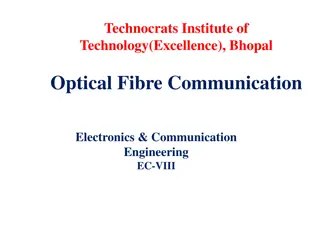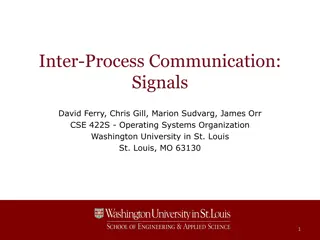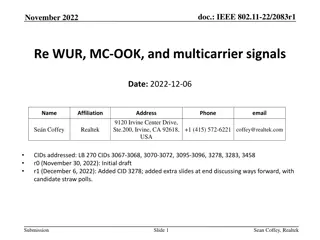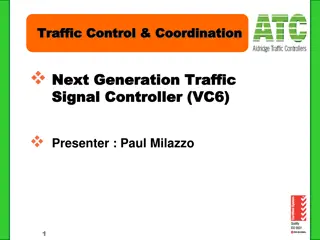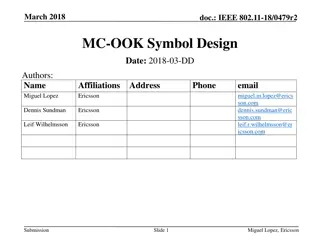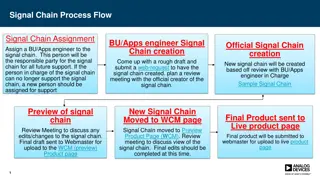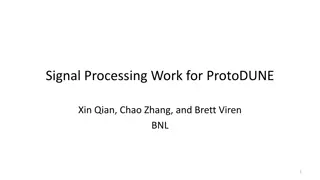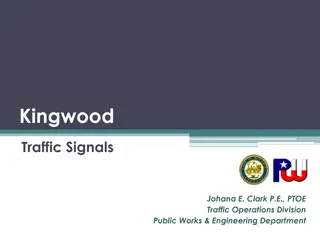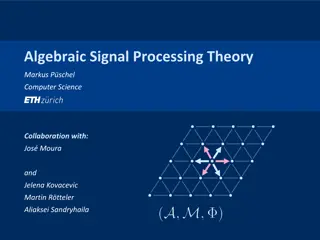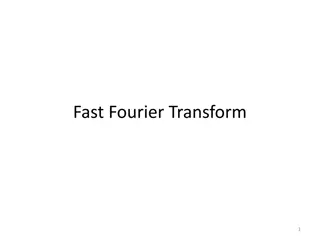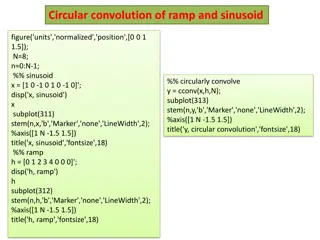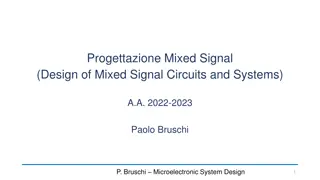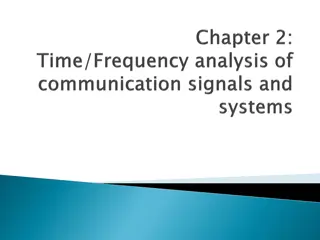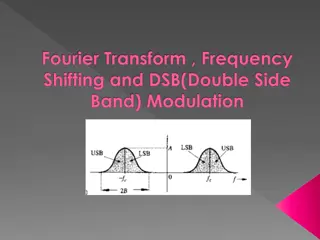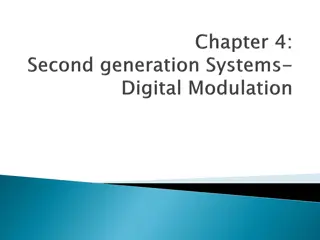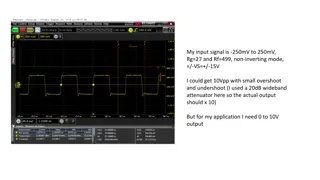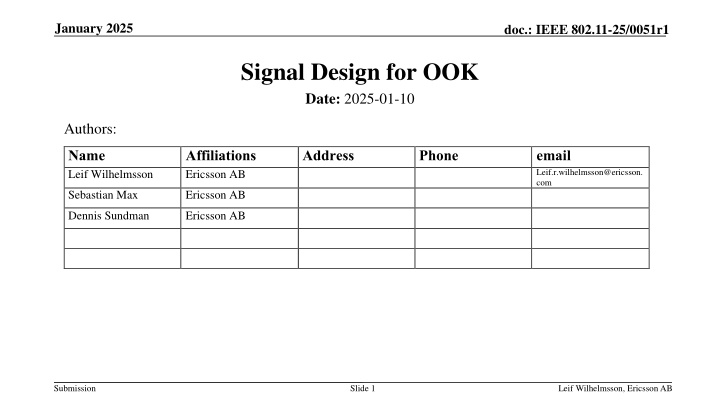
IEEE 802.11-25/0051r1 Signal Design for OOK in January 2025
"Explore the signal design for OOK (On-Off Keying) in IEEE 802.11-25/0051r1 document from January 2025, emphasizing the benefits of using a large bandwidth for improved frequency diversity and TX power. The proposed approach involves multi-carrier OOK (MC-OOK) to achieve desired signal properties and enhance transmission bandwidth."
Download Presentation

Please find below an Image/Link to download the presentation.
The content on the website is provided AS IS for your information and personal use only. It may not be sold, licensed, or shared on other websites without obtaining consent from the author. If you encounter any issues during the download, it is possible that the publisher has removed the file from their server.
You are allowed to download the files provided on this website for personal or commercial use, subject to the condition that they are used lawfully. All files are the property of their respective owners.
The content on the website is provided AS IS for your information and personal use only. It may not be sold, licensed, or shared on other websites without obtaining consent from the author.
E N D
Presentation Transcript
January 2025 doc.: IEEE 802.11-25/0051r1 Signal Design for OOK Date: 2025-01-10 Authors: Name Leif Wilhelmsson Affiliations Ericsson AB Address Phone email Leif.r.wilhelmsson@ericsson. com Sebastian Max Ericsson AB Dennis Sundman Ericsson AB Submission Slide 1 Leif Wilhelmsson, Ericsson AB
January 2025 doc.: IEEE 802.11-25/0051r1 Abstract It has been shown that it is advantageous to use a large bandwidth even if the data rate is low, partly because of improved frequency diversity, partly because higher TX power can be used in PSD limited regions. In this contribution ways to generate Manchester-coded OOK of rate 1 Mb/s and 250 kb/s to allow for a large transmission bandwidth are proposed. The approach is based on multi-carrier OOK (MC-OOK), and key features of MC-OOK are highlighted. Submission Slide 2 Leif Wilhelmsson, Ericsson AB
January 2025 doc.: IEEE 802.11-25/0051r1 Outline Discussion of desired signal properties Signal design to achieve the desired properties Briefly about MC-OOK Conclusions Straw Polls Submission Slide 3 Leif Wilhelmsson, Ericsson AB
January 2025 doc.: IEEE 802.11-25/0051r1 Discussion of desired OOK signal properties The signal should be as wideband as possible, still within the 20 MHz spectrum mask [1] to obtain maximum frequency diversity. The same argument highlighted also for UL in [2]. The signal should be as flat as possible in frequency to allow for maximum TX power in PSD limited regions [3][4]. MC-OOK is a nice approch to achive this, and is therefore considered preferred compared to single-carrier OOK, which has been discussed in e.g. [5][6]. Submission Slide 4 Leif Wilhelmsson, Ericsson AB
January 2025 doc.: IEEE 802.11-25/0051r1 Briefly about MC-OOK Waveform PAPR (dB) SNR (dB) @10% PER AWGN SNR (dB) @10% PER TGnB SNR (dB) @10% PER TGnD Random QPSK > 5 -4.1 4.8 1.7 1.0 Best tradeoff [3] 3.5 -4.1 4.7 0.6 -4.7 4.6 Proposed no DC 1.3 MC-OOK is not using OFDM. OFDM means data is multiplexed on different sub-carriers and the time signal depends on the data. As a result, the PAPR is high and one has to back-off the PA. In MC-OOK the complex input to the IFFT can be selected to achieve low PAPR, a flat spectrum, or a suitable trade-off. In [7], a design with PAPR = 0.6 dB was proposed for both data rates. Submission Slide 5 Leif Wilhelmsson, Ericsson AB
January 2025 doc.: IEEE 802.11-25/0051r1 Signal design to achieve the desired properties: 250kb/s 250 kb/s fits very nicely with MC-OOK if FFT size = 32 and CP = 0.4 s IEEE 802.11ba used only 6 sub-carriers + DC, resulting in a 4 MHz signal It is possible to use up to 28 sub-carriers + DC with a simple window to fulfill the TX spectrum mask Submission Slide 6 Leif Wilhelmsson, Ericsson AB
January 2025 doc.: IEEE 802.11-25/0051r1 Signal design to achieve the desired properties: 1 Mb/s To generate 1 Mb/s, one may use an 8 point FFT (or 64 point FFT with only every 8 bin populated and then truncate after of the symbol time) Alt 1: Use 5 sub-carriers (4 + DC) to get it symmetric Submission Slide 7 Leif Wilhelmsson, Ericsson AB
January 2025 doc.: IEEE 802.11-25/0051r1 Signal design to achieve the desired properties: 1 Mb/s Alt 2: Use 6 sub-carriers, shifted 1.25 MHz to get it symmetric. Still with an 8 point FFT. Above a low-pass filter (LPF) is used instead of windowing to fulfill the TX mask. Submission Slide 8 Leif Wilhelmsson, Ericsson AB
January 2025 doc.: IEEE 802.11-25/0051r1 Signal design to achieve the desired properties: 1 Mb/s Because of the small IFFT size, the variations in PSD will reduce the total allowed power in case of PSD limited transmission, as the PSD is measured over 1 MHz. To reduce these variations, randomization in frequency may be used. The sub-carriers used for generating the signal are changed from one symbol to the next. E.g. shifted by 2.5 MHz/8 = 312.5 kHz. For the 250 kb/s mode one may also do this randomization to minimize the variations, but since the variations are within the 1 MHz measurement bandwidth the gain is negligible. Submission Slide 9 Leif Wilhelmsson, Ericsson AB
January 2025 doc.: IEEE 802.11-25/0051r1 Signal design to achieve the desired properties: 1 Mb/s With randomization Without randomization Because of the randomization in frequency, the PSD becomes much more flat, allowing for increased TX power in PSD limited regions. Alt 1: Use 5 sub-carriers (4 + DC) to get it symmetric. Submission Slide 10 Leif Wilhelmsson, Ericsson AB
January 2025 doc.: IEEE 802.11-25/0051r1 Signal design to achieve the desired properties: 1 Mb/s With randomization Without randomization Alt 2: Use 6 sub-carriers, shifted 1.25 MHz to get it symmetric. Submission Slide 11 Leif Wilhelmsson, Ericsson AB
January 2025 doc.: IEEE 802.11-25/0051r1 1 Mb/s - Discussion Possible to fulfil the TX mask with a 15 MHz signal (6 sub-carriers and 8 point IFFT) + windowing or filtering. Windowing mainly effective far from passband, whereas a LPF also can attenuate at the critical point 11 MHz. Typically, how to fulfil TX mask is implementation specific. Submission Slide 12 Leif Wilhelmsson, Ericsson AB
January 2025 doc.: IEEE 802.11-25/0051r1 Sensitivity performance - Discussion It was mentioned during the presentation at the November f2f, that no CSF (channel selective filter) at all is assumed. There would be an advantage with a NB signal if a CSF is used as then the SNR at the input to the envelope detector would be increased. Without the CSF, this advantage is not present. The two advantages with a WB signal are still present, that is Better frequency diversity Higher TX power in case of PSD limited transmission Based on the results in [1], showing a large gain using wideband transmission, it is recommended to use as large bandwidth as seen feasilble. Submission Slide 13 Leif Wilhelmsson, Ericsson AB
January 2025 doc.: IEEE 802.11-25/0051r1 Conclusions Due to the large gain in performance using a wideband signal, it is suggested that the DL OOK signal should be wideband: 12 MHz - 15 MHz seems feasible. MC-OOK was introduced in 802.11ba, and it is suggested to use the same approach in 802.11bp for generating OOK. To achieve a flatter PSD for the 1 Mb/s mode, it is proposed that the MC- OOK signal may be generated such that the individual symbols are frequency shifted with respect to one another. Submission Slide 14 Leif Wilhelmsson, Ericsson AB
January 2025 doc.: IEEE 802.11-25/0051r1 References 1. 2. Leif Wilhelmsson et al., Some observations related to OOK , IEEE 802.11-24/1529r0. Steve Shellhammer et al., Robust Methods for AMP Active Uplink Multiple Data Rate Support , IEEE 802.11-24/1794r0. Steve Shellhammer et al., Regulations and Noise Figure Impact on SNR , IEEE 802.11-17/0365r0 . Leif Wilhelmsson et al, Spec Text on Spectral Flatness , IEEE 802.11-18/1643r1. Weng Ke et al., OOK generation for AMP DL , IEEE 802.11-24/1802r0. Steve Shellhammer et al., AMP Downlink Data Rates , IEEE 802.11-24/1793r1. Miguel Lopez et al. MC-OOK Symbol Design , IEEE 802.11-18/0479r2. 3. 4. 5. 6. 7. Submission Slide 15 Leif Wilhelmsson, Ericsson AB
January 2025 doc.: IEEE 802.11-25/0051r1 Straw Poll 1 Do you agree to include the following text to the 11bp SFD: Multicarrier on-off keying (MC-OOK ) is supported for DL AMP PHY. Y/N/A: Submission Slide 16 Leif Wilhelmsson, Ericsson AB
January 2025 doc.: IEEE 802.11-25/0051r1 Straw Poll 2 Do you agree that the OOK used for DL tranmission shall have a (3 dB) bandwidth of at least 10 MHz? Y/N/A: Submission Slide 17 Leif Wilhelmsson, Ericsson AB
January 2025 doc.: IEEE 802.11-25/0051r1 Straw Poll 3 Do you agree that for the 1 Mb/s mode, the signal for different ON symbols may have different frequency content, e.g. may be generated as described on page 8? Y/N/A: Submission Slide 18 Leif Wilhelmsson, Ericsson AB

